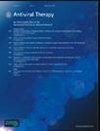HBV co-infection is associated with persistently elevated liver stiffness measurement in HIV-positive adults: A 6-year single-centre cohort study in Nigeria
IF 2.3
4区 医学
Q4 INFECTIOUS DISEASES
引用次数: 0
Abstract
Background In Nigeria, the effect of Hepatitis B virus (HBV) on long-term liver outcomes in persons with HIV (PLH) has not been described. We determined changes in liver stiffness measure (LSM) using transient elastography over 6 years in HIV mono-infected and HIV-HBV co-infected Nigerians initiating antiretroviral therapy (ART) and factors associated with LSM decline. Methods This single centre, cohort study enrolled ART-naïve HIV mono- and HIV-HBV co-infected adults (≥18 years) at the APIN Public Health Initiatives–supported HIV Care and Treatment Centre at Jos University Teaching Hospital, Nigeria, from 7/2011 to 2/2012. LSM at baseline, Years 3 and 6 were analysed using longitudinal models to estimate changes over time and their predictors. Results Data from 100 (31%) HIV-HBV co-infected and 225 (69%) HIV mono-infected participants were analysed. Median LSM at baseline was 6.10 (IQR: 4.60–7.90) kPa in co-infected and 5.10 (IQR: 4.40–6.10) kPa in mono-infected participants. In adjusted analyses, average LSM was not significantly different between Year 0 and 3 (β = 0.02, −0.22 to 0.26, p = 0.87 and Year 0 and 6 (β = −0.02, −0.23 to 0.27, p = 0.88) in both groups (p>0.05), but co-infected participants had significantly higher LSM than mono-infected throughout follow-up (β = 0.018, 0.019–0.28, p < 0.001). Year 3 LSM differed according to ART initiation status by Year 3 (initiators - non-initiators: −0.87, −1.70 to −0.29). Conclusion In this cohort, LSM remained higher among HIV-HBV co-infected versus HIV mono-infected participants throughout follow-up. Our findings emphasize the continuing need for monitoring of liver outcomes in HIV-HBV co-infected populations on ART and the importance of preventing HBV infection among PLH to optimize liver health.HBV合并感染与hiv阳性成人肝脏硬度测量持续升高有关:尼日利亚一项为期6年的单中心队列研究
背景:在尼日利亚,乙型肝炎病毒(HBV)对HIV感染者(PLH)长期肝脏预后的影响尚未被描述。我们使用瞬时弹性成像技术确定了在6年多的时间里,单HIV感染和HIV- hbv合并感染的尼日利亚人开始抗逆转录病毒治疗(ART)时肝脏硬度测量(LSM)的变化以及与LSM下降相关的因素。方法这项单中心队列研究于2011年7月至2012年2月在尼日利亚乔斯大学教学医院APIN公共卫生倡议支持的艾滋病毒护理和治疗中心招募了ART-naïve单HIV和HIV- hbv合并感染的成年人(≥18岁)。使用纵向模型分析基线、第3年和第6年的LSM,以估计随时间的变化及其预测因子。结果分析了100名HIV- hbv合并感染者(31%)和225名HIV单感染者(69%)的数据。基线时,合并感染的中位LSM为6.10 (IQR: 4.60-7.90) kPa,单一感染的中位LSM为5.10 (IQR: 4.40-6.10) kPa。在校正分析中,两组的平均LSM在第0年和第3年(β = 0.02, - 0.22至0.26,p = 0.87)和第0年和第6年(β = - 0.02, - 0.23至0.27,p = 0.88)之间无显著差异(p < 0.05),但在整个随访过程中,合并感染的参与者的LSM显著高于单独感染的参与者(β = 0.018, 0.019-0.28, p < 0.001)。3年级的LSM根据ART起始状态而不同(起始者-非起始者:−0.87,−1.70至−0.29)。在该队列中,在整个随访过程中,HIV- hbv合并感染者的LSM高于HIV单感染者。我们的研究结果强调了持续监测HIV-HBV合并感染人群接受抗逆转录病毒治疗的肝脏结局的必要性,以及预防PLH中HBV感染以优化肝脏健康的重要性。
本文章由计算机程序翻译,如有差异,请以英文原文为准。
求助全文
约1分钟内获得全文
求助全文
来源期刊

Antiviral Therapy
医学-病毒学
CiteScore
2.60
自引率
8.30%
发文量
35
审稿时长
4-8 weeks
期刊介绍:
Antiviral Therapy (an official publication of the International Society of Antiviral Research) is an international, peer-reviewed journal devoted to publishing articles on the clinical development and use of antiviral agents and vaccines, and the treatment of all viral diseases. Antiviral Therapy is one of the leading journals in virology and infectious diseases.
The journal is comprehensive, and publishes articles concerning all clinical aspects of antiviral therapy. It features editorials, original research papers, specially commissioned review articles, letters and book reviews. The journal is aimed at physicians and specialists interested in clinical and basic research.
 求助内容:
求助内容: 应助结果提醒方式:
应助结果提醒方式:


